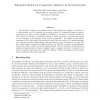Free Online Productivity Tools
i2Speak
i2Symbol
i2OCR
iTex2Img
iWeb2Print
iWeb2Shot
i2Type
iPdf2Split
iPdf2Merge
i2Bopomofo
i2Arabic
i2Style
i2Image
i2PDF
iLatex2Rtf
Sci2ools
WINE
2010
Springer
2010
Springer
Threshold Models for Competitive Influence in Social Networks
The problem of influence maximization deals with choosing the optimal set of nodes in a social network so as to maximize the resulting spread of a technology (opinion, productownership, etc.), given a model of diffusion of influence in a network. A natural extension of this would be to introduce a competitive setting, in which the goal is to maximize the spread of our technology in the presence of one or more competitors. We suggest several natural extensions to the well-studied linear-threshold model that was used in the single-technology case, and show that the original greedy approach cannot be used. Furthermore, we show that for a broad family of competitive influence models, it is NP-hard to achieve an approximation that is better than a square root of the optimal solution. Also, we show that the same proof of hardness of approximation can also be applied to give a negative result for a conjecture in [2] about a general cascade model for competitive diffusion. Finally, we suggest...
Economy | Greedy Approach | Model | Natural Extensions | WINE 2010 |
| Added | 15 Feb 2011 |
| Updated | 15 Feb 2011 |
| Type | Journal |
| Year | 2010 |
| Where | WINE |
| Authors | Allan Borodin, Yuval Filmus, Joel Oren |
Comments (0)

